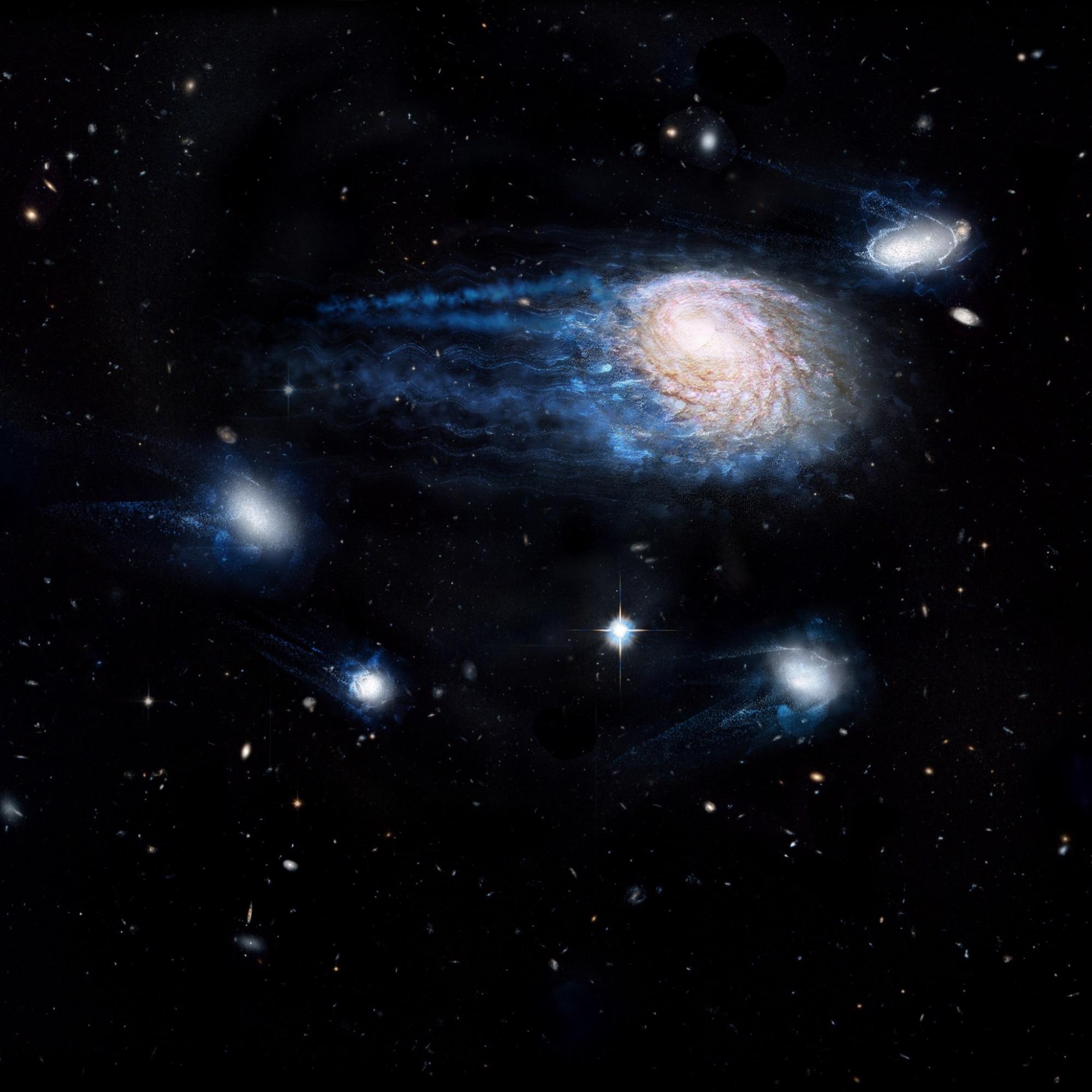Feb 23 2021
A known fact is that large galaxies tend to steal the gas found in the space between the stars in smaller satellite galaxies. A new, recently published study has discovered that the small satellite galaxies also have less 'molecular' gas at their centers.
 An artist’s impression showing the increasing effect of ram-pressure stripping in removing gas from galaxies, sending them to an early death. Image Credit: ICRAR, NASA, ESA, the Hubble Heritage Team (STScI/AURA).
An artist’s impression showing the increasing effect of ram-pressure stripping in removing gas from galaxies, sending them to an early death. Image Credit: ICRAR, NASA, ESA, the Hubble Heritage Team (STScI/AURA).
At the centers of galaxies, molecular gas exists as giant clouds and forms the building material for new stars. Thus, large galaxies are stripping the material required by their smaller counterparts to form new stars.
Dr Adam Stevens, the lead author of this study, is an astrophysicist based at UWA working for the International Centre for Radio Astronomy Research (ICRAR), as well as affiliated to the ARC Centre of Excellence in All Sky Astrophysics in 3 Dimensions (ASTRO 3D).
According to him, the study offers new systematic proof that universally, small galaxies tend to lose a portion of their molecular gas when they reach closer to a larger galaxy and the gas halo surrounding the larger galaxy.
Gas is the lifeblood of a galaxy. Continuing to acquire gas is how galaxies grow and form stars. Without it, galaxies stagnate. We’ve known for a long time that big galaxies strip ‘atomic’ gas from the outskirts of small galaxies. But, until now, it hadn’t been tested with molecular gas in the same detail.
Dr Adam Stevens, Astrophysicist, ICRAR-UWA
According to ICRAR-UWA astronomer Barbara Catinella, who is also an Associate Professor, galaxies do not usually exist in isolation.
Most galaxies have friends. And when a galaxy moves through the hot intergalactic medium or galaxy halo, some of the cold gas in the galaxy is stripped away. This fast-acting process is known as ram pressure stripping.
Barbara Catinella, Astronomer and Associate Professor, ICRAR-UWA
The study was an international collaboration including scientists from the University of Maryland, Max Planck Institute for Astronomy, University of Heidelberg, Harvard-Smithsonian Center for Astrophysics, University of Bologna, and Massachusetts Institute of Technology.
The direct detection of molecular gas is extremely difficult.
The researchers of this study performed an advanced cosmological simulation and carried out direct predictions for the amount of atomic and molecular gas that should be detected by certain surveys on the Arecibo telescope in Puerto Rico and the IRAM 30 meter telescope in Spain.
Then, they compared the actual observations of the telescopes with their original predictions. Astonishingly, both values were very close.
Associate Professor Catinella, who headed the Arecibo survey of atomic gas, added that the IRAM 30 m telescope detected the molecular gas in over 500 galaxies.
“These are the deepest observations and largest sample of atomic and molecular gas in the local Universe. That’s why it was the best sample to do this analysis,” she added.
The results achieved by the team fit with earlier proof that satellite galaxies exhibit lower star formation rates. According to Dr Stevens, stripped gas first enters the space around the larger galaxy.
“That may end up eventually raining down onto the bigger galaxy, or it might end up just staying out in its surroundings,” he noted.
However, in a majority of the cases, the small galaxy is destined to merge with the larger one eventually.
Often they only survive for one to two billion years and then they’ll end up merging with the central one. So it affects how much gas they’ve got by the time they merge, which then will affect the evolution of the big system as well. Once galaxies get big enough, they start to rely on getting more matter from the cannibalism of smaller galaxies.
Dr Adam Stevens, Astrophysicist, ICRAR-UWA
Big galaxies steal star-forming gas from their smaller neighbours
Fly-through of galaxies having their gas stripped in the IllustrisTNG simulation. Video Credit: ICRAR.
Journal Reference:
Stevens, A. R. H., et al. (2020) Molecular hydrogen in IllustrisTNG galaxies: carefully comparing signatures of environment with local CO & SFR data. Monthly Notices of the Royal Astronomical Society. doi.org/10.1093/mnras/staa3662.